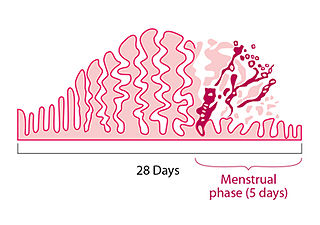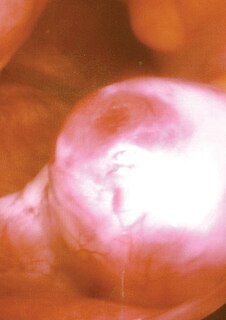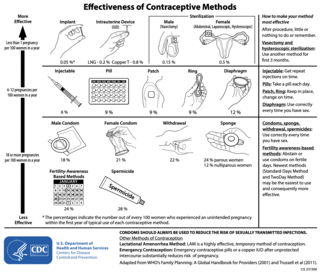Related Research Articles

Emergency contraception (EC) is a birth control measure, used after sexual intercourse to prevent pregnancy.

Fertility awareness (FA) refers to a set of practices used to determine the fertile and infertile phases of a woman's menstrual cycle. Fertility awareness methods may be used to avoid pregnancy, to achieve pregnancy, or as a way to monitor gynecological health.

The combined oral contraceptive pill (COCP), often referred to as the birth control pill or colloquially as "the pill", is a type of birth control that is designed to be taken orally by women. It includes a combination of an estrogen and a progestogen. When taken correctly, it alters the menstrual cycle to eliminate ovulation and prevent pregnancy.
Calendar-based methods are various methods of estimating a woman's likelihood of fertility, based on a record of the length of previous menstrual cycles. Various methods are known as the Knaus–Ogino method and the rhythm method. The standard days method is also considered a calendar-based method, because when using it, a woman tracks the days of her menstrual cycle without observing her physical fertility signs. The standard days method is based on a fixed formula taking into consideration the timing of ovulation, the functional life of the sperm and the ovum, and the resulting likelihood of pregnancy on particular days of the menstrual cycle. These methods may be used to achieve pregnancy by timing unprotected intercourse for days identified as fertile, or to avoid pregnancy by avoiding unprotected intercourse during fertile days.

Menstruation is the regular discharge of blood and mucosal tissue from the inner lining of the uterus through the vagina. The menstrual cycle is characterized by the rise and fall of hormones. Menstruation is triggered by falling progesterone levels and is a sign that pregnancy has not occurred.

The menstrual cycle is a series of natural changes in hormone production and the structures of the uterus and ovaries of the female reproductive system that make pregnancy possible. The ovarian cycle controls the production and release of eggs and the cyclic release of estrogen and progesterone. The uterine cycle governs the preparation and maintenance of the lining of the uterus (womb) to receive a fertilized egg. These cycles are concurrent and coordinated, normally last between 21 and 35 days in adult women, with a median length of 28 days, and continue for about 30–45 years.

Ovulation is the release of eggs from the ovaries. In women, this event occurs when the ovarian follicles rupture and release the secondary oocyte ovarian cells. After ovulation, during the luteal phase, the egg will be available to be fertilized by sperm. In addition, the uterine lining (endometrium) is thickened to be able to receive a fertilized egg. If no conception occurs, the uterine lining as well as the egg will be shed during menstruation.
Mittelschmerz is a colloquial term for "ovulation pain" or "midcycle pain". About 20% of women experience mittelschmerz, some every cycle, some intermittently.

Dysmenorrhea, also known as painful periods or menstrual cramps, is pain during menstruation. Its usual onset occurs around the time that menstruation begins. Symptoms typically last less than three days. The pain is usually in the pelvis or lower abdomen. Other symptoms may include back pain, diarrhea or nausea.
Anovulation is when the ovaries do not release an oocyte during a menstrual cycle. Therefore, ovulation does not take place. However, a woman who does not ovulate at each menstrual cycle is not necessarily going through menopause. Chronic anovulation is a common cause of infertility.
The anovulatory cycle is a menstrual cycle by varying degrees of menstrual intervals and the absence of ovulation and a luteal phase. In the absence of ovulation, there will be infertility.
Natural family planning (NFP) comprises the family planning methods approved by the Catholic Church and some Protestant denominations for both achieving and postponing or avoiding pregnancy. In accordance with the Church's teachings regarding sexual behavior, NFP excludes the use of other methods of birth control, which it refers to as "artificial contraception".

Lactational amenorrhea, also called postpartum infertility, is the temporary postnatal infertility that occurs when a woman is amenorrheic and fully breastfeeding.
Hormonal contraception refers to birth control methods that act on the endocrine system. Almost all methods are composed of steroid hormones, although in India one selective estrogen receptor modulator is marketed as a contraceptive. The original hormonal method—the combined oral contraceptive pill—was first marketed as a contraceptive in 1960. In the ensuing decades many other delivery methods have been developed, although the oral and injectable methods are by far the most popular. Hormonal contraception is highly effective: when taken on the prescribed schedule, users of steroid hormone methods experience pregnancy rates of less than 1% per year. Perfect-use pregnancy rates for most hormonal contraceptives are usually around the 0.3% rate or less. Currently available methods can only be used by women; the development of a male hormonal contraceptive is an active research area.

There are many methods of birth control. They vary in what is required of the user, side effects, and effectiveness. No method of birth control is ideal for every user. Outlined here are the different types of barrier methods, hormonal methods, various methods including spermicides, emergency contraceptives, and surgical methods.

An intrauterine device (IUD), also known as intrauterine contraceptive device or coil, is a small, often T-shaped birth control device that is inserted into the uterus to prevent pregnancy. IUDs are one form of long-acting reversible birth control (LARC). One study found that female family planning providers choose LARC methods more often (41.7%) than the general public (12.1%). Among birth control methods, IUDs, along with other contraceptive implants, result in the greatest satisfaction among users.

CycleBeads is a visual tool that was developed by the Institute for Reproductive Health at Georgetown University. This device helps women use the Standard Days Method, a fertility awareness-based family planning method.

Fertility testing is the process by which fertility is assessed, both generally and also to find the "fertile window" in the menstrual cycle. General health affects fertility, and STI testing is an important related field.
The ovulatory shift hypothesis holds that women experience evolutionarily adaptive changes in subconscious thoughts and behaviors related to mating during different parts of the ovulatory cycle. It suggests that what women want, in terms of men, changes throughout the menstrual cycle. Two meta-analyses published in 2014 reached opposing conclusions on whether the existing evidence was robust enough to support the prediction that women's mate preferences change across the cycle. A newer 2018 review does not show women changing the type of men they desire at different times in their fertility cycle.
Menstrual suppression refers to the practice of using hormonal management to stop or reduce menstrual bleeding. In contrast to surgical options for this purpose, such as hysterectomy or endometrial ablation, hormonal methods to manipulate menstruation are reversible.
References
- 1 2 3 Grimes DA, Gallo MF, Halpern V, Nanda K, Schulz KF, Lopez LM (2004). "Family planning with methods based on fertility awareness | Cochrane". Cochrane Database of Systematic Reviews (4): CD004860. doi:10.1002/14651858.CD004860.pub2. PMC 8855505 . PMID 15495128.
- ↑ Baker, Fiona C.; Waner, Jonathan I.; Vieira, Elizabeth F.; Taylor, Sheila R.; Driver, Helen S.; Mitchell, Duncan (2001-02-01). "Sleep and 24 hour body temperatures: a comparison in young men, naturally cycling women and women taking hormonal contraceptives". The Journal of Physiology. 530 (3): 565–574. doi:10.1111/j.1469-7793.2001.0565k.x. ISSN 1469-7793. PMC 2278431 . PMID 11158285.
- 1 2 3 4 Coward, Kevin; Wells, Dagan (2013-10-31). Textbook of Clinical Embryology. Cambridge University Press. pp. 145, 156. ISBN 9780521166409.
- 1 2 Grimes, David A.; Gallo, Maria F.; Halpern, Vera; Nanda, Kavita; Shulz, Kenneth F.; Lopez, Laureen M. (October 2004). "Fertility awareness‐based methods for contraception". Cochrane Database of Systematic Reviews. 2004 (4): CD004860. doi:10.1002/14651858.CD004860.pub2. PMC 8855505 . PMID 15495128.
- 1 2 3 4 Cunningham, F. Gary (2014). Williams Obstetrics (24th ed.). New York: McGraw-Hill Education/Medical. pp. 696, 713. ISBN 9780071798938. OCLC 871619675.
- ↑ Trussell, James (2011). "Contraceptive failure in the United States". Contraception. 83 (5): 397–404. doi:10.1016/j.contraception.2011.01.021. ISSN 0010-7824. PMC 3638209 . PMID 21477680.
- ↑ Family planning : a global handbook for providers : evidence-based guidance developed through worldwide collaboration. Baltimore: Johns Hopkins, Bloomberg School of Public Health, Center for Communication Programs, INFO Project. 2011. ISBN 9780978856304. OCLC 776090067.
- 1 2 Taylor, Robert B. (2012-12-06). Taylor's Family Medicine Review. Springer Science & Business Media. p. 40. ISBN 9781461221524.